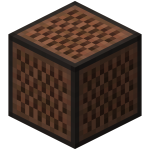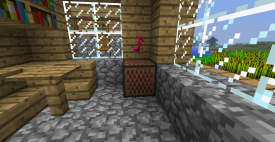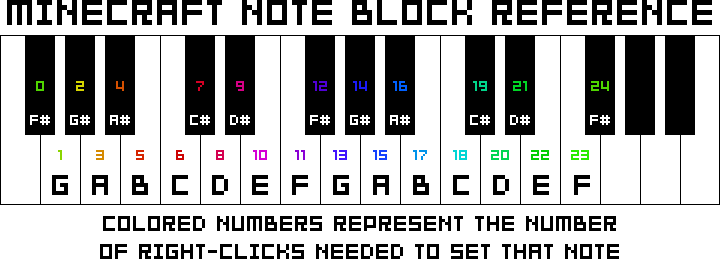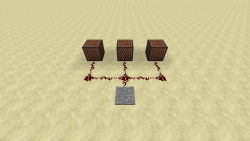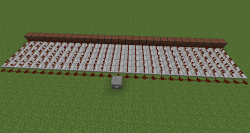Diferencia entre revisiones de «Bloque musical»
| Línea 1: | Línea 1: | ||
| − | {{ | + | {{Construcción}} |
{{Block | {{Block | ||
|tipo=Bloque Sólido | |tipo=Bloque Sólido | ||
Revisión del 22:44 14 jul 2014
| Tipo |
Bloque Sólido |
| Requerimientos |
Ninguno |
| Físicas |
No |
| Transparencia |
No |
| Iluminación |
No |
| Resistencia a explosiones |
1 |
| Dureza |
0,8 |
| Herramienta | |
| Renovable |
Sí |
| Apilable |
Sí (64) |
| Inflamable |
No |
| Primera aparición | |
| Otorga | |
| Valor de datos |
dec: 25 hex: 19 bin: 11001 |
| Nombre |
noteblock |
Un bloque musical es un bloque que reproduce una sola nota al ser golpeado por el jugador o alimentado por redstone. Se puede conectar de esta manera un número indeterminado de bloques musicales para crear música.
Los bloques musicales se activaran cuando estén al lado de un bloque potenciado, lo que permite circuitos de música más compactos.
Contenido
Construcción
Los bloques de nota se pueden construir colocando 8 tablas de madera en forma de cuadrado con polvo de Redstone en el centro:
| Ingredientes | Input » Output | ||||||||||||
|---|---|---|---|---|---|---|---|---|---|---|---|---|---|
| Tablas de Madera + Polvo de Redstone |
|
Musica
Los bloques musicales tocan una nota coloreada al ser golpeados por uno o al tocar una corriente de Redstone. Una corriente de Redstone solo hace que suene una nota, aunque sea una corriente continua. El bloque debe tener por lo menos un bloque de aire sobre el para tocar una nota. Estas pueden oírse a una distancia de hasta 48 bloques.
Cada vez que un bloque toca una nota, una partícula en forma de nota musical volará sobre el, con el color dependiendo de la altura del sonido (pero no del instrumento).
Hacer clic derecho en un bloque sube la nota en un medio tono, con un total de dos octavas disponibles para tocar. El rango de estas notas es entre Fa#3 a Fa#5. Al alcanzar la nota mas alta, al hacer clic derecho nuevamente vuelve a Fa#3, también sucede esto al recoger el bloque y colocarlo de nuevo. La relación exacta entre clics y nota esta abajo.[1]
|
|
Alternativamente, hay una versión gráfica disponible:
You can roughly check the tuning of a block by looking at the note icon.
El instrumento tocado depende del bloque que haya debajo del bloque de nota:
| Tipo de Bloque | Instrumento |
| Bloques de madera (incluyendo otros bloques de nota) | Contrabajo |
| Arena / Grava / Arena de Alma | Tambor de Caja |
| Vidrio / Glowstone | Clics / Palos |
| Bloques de piedra (ej: minerales) / Obsidiana / Netherrack / Ladrillos | Bombo |
| Tierra y todos los otros bloques incluyendo el Aire | Arpa |
Powering note blocks
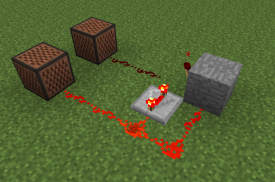
Note blocks can be powered in a variety of different ways following normal redstone principles, however some ways of powering note blocks are more convenient than others or produce unexpected results.
- When a note block is powered by a switch on its side it does play but is often very difficult to hear since the sound of the switch activating is so loud.
- Since note blocks need a space above them, note blocks powered by pressure plates or redstone directly above them do not make a sound.
Sequencing
It is possible to link together a set of inverters, connected to note blocks, which are then played after each other when the first inverter is given power. This can be used to create songs, without having to manually give power to every note (through pressure plates for example). See also: Redstone circuits.
Redstone repeaters greatly simplify the process of timing note blocks in sequence to make melodies. The delay can be set to one, two, three, or four redstone ticks, which is equivalent to 0.1, 0.2, 0.3 and 0.4 seconds.
Another way is putting down a railway of detector rail and powered rails and connect the detector rails to note blocks beside the track. This is useful if you want to hear your music without the degrade in sound as the note blocks play from farther and farther away. However, it is recommended to turn the Players bar in the Sounds menu to 0% to cancel out the minecart sounds, or use a customized resource pack.
Chords
When creating melodies in Minecraft, one will often want to play chords. This is done by playing two or more note blocks at the same time and is relatively easy. Note blocks can be tuned to create harmony or dissonance using the same semitone intervals as on piano or almost any other instrument.
Assuming there is already a sequence of note blocks powered by repeaters:
- Additional note blocks can be placed adjacent to it. when the main note block is powered the adjacent note blocks also become powered on the same tick, creating a chord.
- A redstone wire can be led out of the block in the main sequence. Note blocks placed adjacent to a block with a powered redstone wire on will be powered on the same tick.
Pressure plates - removing the click
Stepping on a pressure plate is a simple way to trigger a note block, but also triggers the pressure plate sound effect. The pressing/clicking sound can easily be removed by turning off the sound of blocks in the options.
History
| Beta | ||
|---|---|---|
| 1.2 | Added note blocks. | |
| Edición consola | ||
| TU1 | Added note blocks. | |
| TU15 | Incorrect sounds(bug). | |
Trivia
- Note blocks start at the pitch F♯/G♭, which is unusual since the note has no significance in any known musical instrument.
- The sound files for the note blocks can be found in assets\sounds\note, you can see that the piano sound is named "harp" and also that there is an unused sound called "pling".
- You can tune a note block even if there is a block above it, however the note will not be seen nor will any sound be made.
- If you are 18 or more blocks away from a note block you will not see the note coming out.
- If you are 47 or more blocks away from a note block you will not hear the sound.
- Note blocks use the same texture as jukeboxes but the top texture is the same as the side textures.
- Triggering (playing) a note block or changing the note played does not count as a block update, however, it provides a comparator update and so this can be detected with a CUD.
- Note blocks are block entities and like all block entities cannot be pushed by pistons. It needs to be a block entity to store what note it's currently set to.
- Note blocks can't play wind instruments.
See also
- Minecraft Note Block Studio - A music editor for Minecraft.
References
External links
| Componentes |
|
||||||
|---|---|---|---|---|---|---|---|
| Circuitos de Redstone | Circuito de reloj • Circuito lógico • Circuito de memoria | ||||||
| Misceláneo |
Mena de redstone |
||||||
- REDIRECT Plantilla:Bloque


